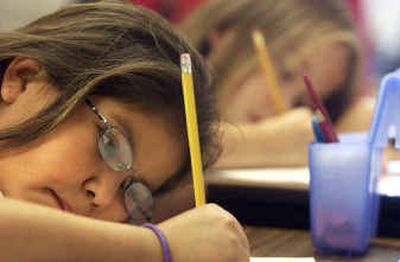State clears area schools

Lakeside Elementary Principal Joe St. John sent out a letter two weeks ago telling parents they could move their children to another school in the district – if another elementary school existed – because the state had labeled the Worley school as “Needs Improvement.”
Friday the principal began drafting a new letter. Lakeside Elementary and several other Idaho schools facing sanctions for failing to meet goals on a statewide test were cleared this week thanks to a change in the state’s interpretation of federal education laws.
The change affected several schools that didn’t meet the state’s goals, but had showed significant improvement from the previous year.
Sanctions against Coeur d’Alene’s Lakes Middle School also were lifted and Woodland Middle School was removed from a watch list of schools not making “Adequate Yearly Progress” or AYP.
A handful of Lakes students had already transferred to another school in the district by the time the district received word that Lakes was no longer a Needs Improvement school. Because the Plummer-Worley School District has only one elementary school, Lakeside Elementary students weren’t able to exercise that option.
Since students were already a week into the school year, Assistant Superintendent Hazel Bauman said the district didn’t plan on transferring those students back to Lakes. But, just like St. John, the district now has to inform parents of the change in status.
The revised AYP reports released by the State Department of Education on Friday show a decrease in the number of schools and districts not making AYP or listed as Needs Improvement.
Originally, 137 schools statewide missed AYP goals and 89 others were listed as Needs Improvement. The new reports list 113 schools as not meeting AYP and 71 as Needs Improvement.
Under the federal education law, No Child Left Behind, all students are expected to meet goals in reading and math by 2014.
Each state develops its own method to test a student’s proficiency in the subjects and sets its own goals.
Idaho tests student proficiency using the Idaho Standards Achievement Test. The goal for 2003-04 was for 66 percent of students to meet proficiency in reading and 51 percent to meet proficiency in math.
To make Adequate Yearly Progress, each school and the district as a whole must meet those goals in several target areas or subgroups of students. In all, there are 42 targets. One missed target means a school doesn’t make AYP and is put on a watch list.
If a school misses any of the targets in the same subject for a second year – even if it’s a different target than the previous year – the entire school is labeled Needs Improvement and faces sanctions. One sanction requires districts to offer choice, or the option to transfer to another district school. The district has to cover any expenses associated with the transfer, including transportation.
Many schools and districts didn’t meet AYP because the subgroup of special education students or students who speak limited English didn’t meet goals. Those students are expected to perform at the same level as any other student.
Educators have said bringing some of the most challenged students to the same level as other students in such a short amount of time is a tall order. Bauman said the increased flexibility the state has granted schools in meeting AYP will buy the district some more time to meet the state’s goals.
“We’re very pleased,” Bauman said Friday. “We know for sure that having the students with disabilities population meet the targets within a year or two is probably unrealistic. It’s going to take more time.”
In a press release Friday, state education officials said the change was “good news.”
State Superintendent of Public Instruction Marilyn Howard said it “lets the strong progress made by some groups be recognized.”
At Lakeside Elementary, a majority of students are Native American. The school also has a high percentage of students who are poor or in special education, two more subgroups that schools are held accountable for by No Child Left Behind.
All three groups didn’t meet the goals in reading, but overall the school increased from 49 percent of students meeting goals the previous year to 66 percent in 2003-04.
“We made progress,” St. John said. “We made very substantial progress in the area of teaching reading and math at this school. We are absolutely a school that made Adequate Yearly Progress, if you just took those words literally.”